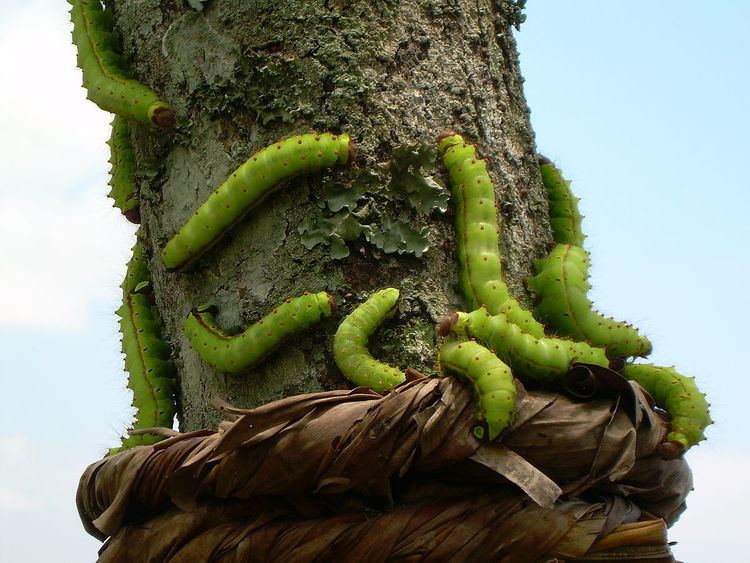 | ||
Wild silks have been known and used in many countries from early times, although the scale of production is far smaller than that from cultivated silkworms.
Contents
Background
Wild silk should not be confused with the very rare sea silk, which is produced from the fibres or byssus produced by the seashell Pinna nobilis and related species.
Commercially reared silkworms of the species Bombyx mori (Linnaeus, 1758) are normally killed before the pupae emerge, either by pricking them with a needle or dipping the cocoons into boiling water, thus allowing the whole cocoon to be unravelled as one continuous thread. This allows a much finer cloth to be woven from the silk.
There are more than 500 species of wild silkworms in the world, although only a few are used to produce cloth. They usually produce a tougher and rougher silk than that from domesticated Bombyx mori silkworms. Wild silks are usually harvested after the moths have left the cocoons, cutting the threads in the process, so that there is not one long thread, as with domesticated silkworms.
Wild silks are more difficult to bleach and dye than silk from Bombyx mori, but most have naturally attractive colours, particularly the rich golden sheen of the silk produced by the muga silkworm from Assam, often known as Assam silk.
The cocoon shells of wild silk moths are toughened or stabilized either by tanning (cross-linking) or by mineral reinforcements (e.g. calcium oxalate). Recently, a new method has been developed, demineralizing, which can remove the mineral reinforcements present in wild silks and enables wet reeling like the commercial silkworm Bombyx mori.
Wild silk industry in India
Wild silks are often referred to in India as 'Vanya' silks:
The term 'Vanya' is of Sanskrit origin, meaning untamed, wild, or forest-based. Muga, Tasar, and Eri silkworms are not fully tamed and the world lovingly calls the silks they produce as 'wild silks'.
India produces four kinds of silk: mulberry, tasar, muga and eri. The silkworm Bombyx mori is fed on mulberry leaves cultivated in plantations. Silkworms are also found wild on forest trees, e.g Antheraea paphia which produces the tasar silk (Tussah). Antheraea paphia feeds on several trees such as Anogeissus latifolia, Terminalia tomentosa, T. arjuna (Terminalia arjuna), Lagerstroemia parviflora and Madhuca indica. Wild silkworm Antheraea assamensis produces muga silk, and another wild silkworm Philosamia synthia ricini (= Samia cynthia) produces eri silk. The estimated annual production of tasar silk is 130 tonnes. Production of other types of silk exceeds 10 000 tonnes (Gupta 1994).
In 2015, Adarsh Gupta K of Nagaraju's research team at Centre for DNA Fingerprinting and Diagnostics, Hyderabad, India discovered the complete sequence and the protein structure of Muga Silk Fibroin and published it in Nature (journal) Scientific Reports
The eri silk worm from India feeds on the leaves of the castor plant. It is the only completely domesticated silkworm other than Bombyx mori. The silk is extremely durable, but cannot be easily reeled off the cocoon and is thus spun like cotton or wool.
Wild silk industry in China
Some of the best quality wild silk is produced by silkworms in Henan. This is the only type of wild silk that can be easily dyed.
History
Wild silk threads have been found and identified from two Indus River sites, Harappa and Chanhu-daro, dating to c. 2450–2000 BCE. This is roughly the same period as the earliest evidence of silk use in China, which is generally thought to have had the oldest silk industry in the world. The specimens of threads from Harappa appear on Scanning electron microscope analysis to be from two different species of silk moth, Antheraea mylitta and A. assamensis, while the silk from Chanhu-daro may be from a Philosamia species, (Eri silk), and this silk appears to have been reeled.
Wild silks were in use in China from early times. Moreover, the Chinese were aware of their use in the Roman Empire and apparently imported goods made from them by the time of the Later Han Dynasty in the 1st to 3rd centuries CE.
There are significant indications in the literature that wild silks were in use in Persia and in Greece by the late 5th century BCE, apparently referred to as "Amorgina" or "Amorgian garments" in Greece.
Pliny the Elder, in the 1st century CE, obviously had some knowledge of how wild silkworms' cocoons were produced and utilised on the island of Kos for Coa vestis, even though his account included some fanciful ideas.
